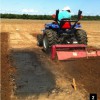 Biochar can potentially provide better conditions in the soil to increase plant growth. However, research has shown that weed species show minimal changes in germination and emergence patterns with the addition of biochar. Regardless, if biochar is used in the field it is important to monitor for changes in weed populations. This is especially important because biochar can decrease herbicide efficacy. This 2-page fact sheet was written by Neeta Soni, Ramon G. Leon, John E. Erickson, and Jason A. Ferrell, and published by the UF Department of Agronomy, March 2015. (Photo: Neeta Soni)
Biochar can potentially provide better conditions in the soil to increase plant growth. However, research has shown that weed species show minimal changes in germination and emergence patterns with the addition of biochar. Regardless, if biochar is used in the field it is important to monitor for changes in weed populations. This is especially important because biochar can decrease herbicide efficacy. This 2-page fact sheet was written by Neeta Soni, Ramon G. Leon, John E. Erickson, and Jason A. Ferrell, and published by the UF Department of Agronomy, March 2015. (Photo: Neeta Soni)
http://edis.ifas.ufl.edu/ag390
Tag: John Erickson
Production of Miscanthus x giganteus for Biofuel (SSAGR292/AG297)
 The bioenergy industry has primarily used Miscanthus for combustion in power plants. It has desirable properties of low water and ash contents following a dry-down period before harvest. Current research is focused on its potential as a biomass crop for direct combustion and for lignocellulosic conversion to ethanol and other biofuels. This 3-page fact sheet was written by John Erickson, Curtis Rainbolt, Yoana Newman, Lynn Sollenberger, and Zane Helsel, and published by the UF Department of Agronomy, September 2012.
The bioenergy industry has primarily used Miscanthus for combustion in power plants. It has desirable properties of low water and ash contents following a dry-down period before harvest. Current research is focused on its potential as a biomass crop for direct combustion and for lignocellulosic conversion to ethanol and other biofuels. This 3-page fact sheet was written by John Erickson, Curtis Rainbolt, Yoana Newman, Lynn Sollenberger, and Zane Helsel, and published by the UF Department of Agronomy, September 2012.
http://edis.ifas.ufl.edu/ag297
Production of Biofuel Crops in Florida: Sweet Sorghum (SSAGR293/AG298)
 Varieties of sorghum with a high concentration of soluble sugars are attractive as a potential energy crop because of the easy accessibility of readily fermentable sugars combined with very high yields of green biomass. Similar to sugarcane, the sap of sweet sorghum is extracted by milling, and can be easily fermented to produce ethanol. Other products from sweet sorghum include syrup, molasses, and crystal sugar. This 3-page fact sheet was written by Wilfred Vermerris, John Erickson, David Wright, Yoana Newman, and Curtis Rainbolt, and published by the UF Department of Agronomy, December 2011.
Varieties of sorghum with a high concentration of soluble sugars are attractive as a potential energy crop because of the easy accessibility of readily fermentable sugars combined with very high yields of green biomass. Similar to sugarcane, the sap of sweet sorghum is extracted by milling, and can be easily fermented to produce ethanol. Other products from sweet sorghum include syrup, molasses, and crystal sugar. This 3-page fact sheet was written by Wilfred Vermerris, John Erickson, David Wright, Yoana Newman, and Curtis Rainbolt, and published by the UF Department of Agronomy, December 2011.
http://edis.ifas.ufl.edu/ag298
SSAGR333/AG343 Forage Sorghum (Sorghum bicolor): Overview and Management
SSAGR333, a 13-page illustrated fact sheet by Yoana Newman, John Erickson, Wilfred Vermerris, and David Wright, provides an overview of the types of sorgum, criteria for selection, cultural practices, pest management, and marketing strategies. Includes references. Published by the UF Department of Agronomy, July 2010.
http://edis.ifas.ufl.edu/ag343